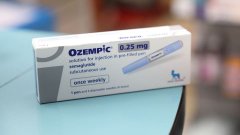
's blockbuster diabetes drug may decrease the risk of in certain patients, demonstrating its potential as an alternative treatment for opioid use disorder, according to a released Wednesday.
The active ingredient in Ozempic, semaglutide, was associated with a "significantly lower" opioid overdose risk than other diabetes medications in people diagnosed with both Type 2 diabetes and opioid use disorder, said the paper published in JAMA Network Open.
The results suggest that Ozempic could offer potential as a tool for addressing the ongoing U.S . opioid epidemic, which was in 2017. There are currently three effective medications to prevent overdoses from opioid use disorder, but a new alternative is needed because some patients simply don't use them, said lead study co-author Dr. , a biomedical informatics professor at Case Western Reserve University.
In 2022, only of patients with opioid use disorder received recommended medications for it, and many discontinued treatment within six months, according to the Centers for Disease Control and Prevention. The National Center for Drug Abuse Statistics says opioids are a factor in of overdose deaths in the U.S.
The study results also add to mounting evidence that a highly popular class of diabetes and obesity treatments called GLP-1s may have several health benefits beyond regulating blood sugar and promoting weight loss. Novo Nordisk, its rival and independent researchers have been racing to study those drugs' potential in patients with chronic conditions ranging from kidney disease and sleep apnea to addictive behaviors such as nicotine and alcohol use.
In the study released Wednesday, researchers from Case Western Reserve University and the National Institutes of Health analyzed the electronic records of nearly 33,000 patients who were prescribed semaglutide or other diabetes medications between December 2017 and June 2023. The study was not funded by Novo Nordisk.
Around 3,000 people were prescribed semaglutide injections, while the remaining patients received treatments that ranged from insulins to older GLP-1s for diabetes. That includes dulaglutide, the active ingredient in Eli Lilly's drug Trulicity, and liraglutide, which is the active ingredient in Novo Nordisk's Victoza.
Researchers monitored how many opioid overdose cases occurred in patients during a one-year period after they stopped treatment with semaglutide or other drugs. For example, there were 42 cases of opioid overdose among a group of patients that received semaglutide, compared with 97 cases among another group that received insulins, according to the study.
That reflects a 58% lower risk of opioid overdose in patients who took semaglutide, Xu said.
But Xu noted the study has limitations since it relies on data from electronic health records.
More research, specifically clinical trials that randomly assign patients to receive semaglutide or other treatments, is needed to confirm how much Ozempic and other GLP-1s can help those with opioid use disorder, according to the study authors. Those randomized studies can also determine whether those treatments are beneficial to the general opioid use disorder population or only certain patients with the condition.
"The extent to which GLP-1 medications could benefit treatment of opioid use disorders and help prevent overdoses is unclear," Dr. Nora Volkow, lead study co-author and director of the National Institute on Drug Abuse of the National Institutes of Health, said in a statement to CNBC. "The preliminary findings from this study point to the possibility that GLP-1 medications may have value in helping to prevent opioid overdoses."
Xu added that the researchers plan to study semaglutide in patients with opioid use disorder and obesity.



